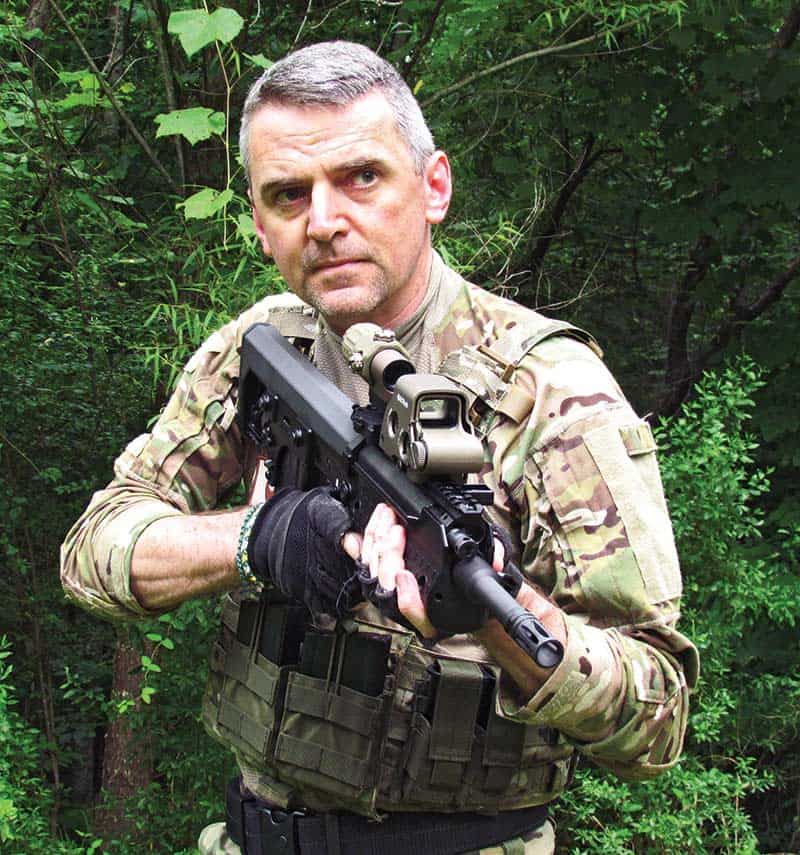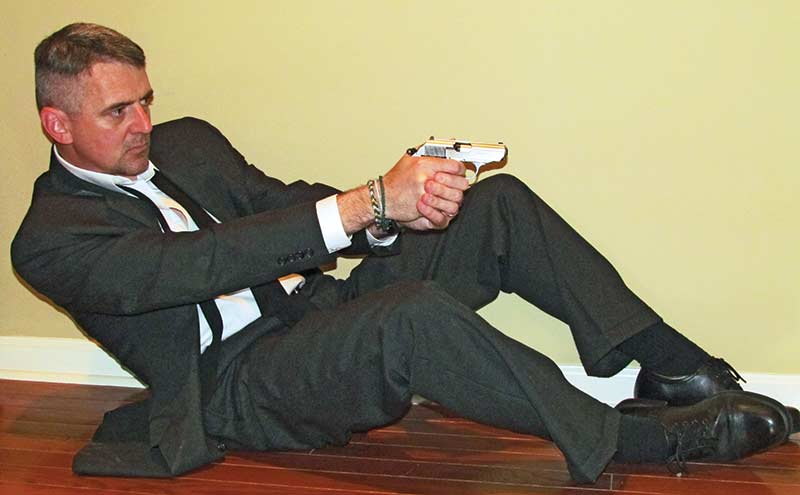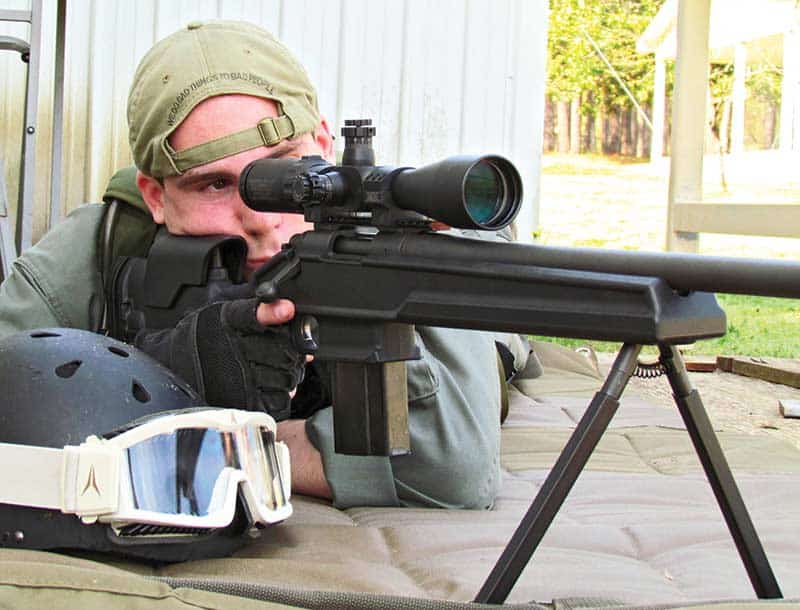Faster Than A Speeding Bullet
The Physiology Involved In Reflexive Gun
Handling Is Truly A Miracle Of Movement
It was a beautiful spring day in rural Mississippi and my two boys and I were in our element. The family term was “going on an explore” and such Saturday walks in the woods frequently turned up turtle shells, bones, unusual plants or cool rocks that made the outing both fun and educational. As I was outside the house, I was packing a gun in a shoulder holster—in this case a Smith and Wesson .22 with a 12-round magazine.
The weather was warm without being hot, so the mosquitoes had not yet quite arrived in force. I was on point so as to minimize subsequent encounters with spider webs and those annoying green sticker vines. I positioned myself to step across a little tributary, a tiny stream no more than 2 feet across. It was then I felt something move underneath my left foot.
I had fixated on the far side of the little brook and had failed to watch where I was putting my foot and got a rude surprise. The water moccasin was as big as my arm and arrayed in a lazy S-shape, its well-camouflaged body blending perfectly with the surrounding foliage. Under the pressure of my boot, the snake cocked its massive head and threw open its jaws to reveal that spine-chilling white responsible for the nickname of “cottonmouth.” My 6-year-old was a few feet behind me and closing fast. There wasn’t time to speak.
The world exploded and mud, debris and bloody pieces of snake showered down around us. Before I had any conscious thought the slide was locked back and the spent magazine was on the ground, the empty gun now anxiously awaiting the fresh one I’d failed to drop into my pants pocket before we left the house.
After we all took a deep breath and gathered our wits, we had opportunity to talk about snakes, guns and fieldcraft as we finished our stroll—albeit a bit more carefully from then on.
I love to shoot but I’m not an exceptional shot. I can operate most anything that throws bullets but they’ll never be singing my praises in the sweat lodge as a world-class pistolero or wingshooter. I just enjoy the mechanical challenge of running a gun. As a result, I do have a fair amount of experience at it.
The movements required to register a threat, disengage the thumb break on my holster, draw the gun, deactivate the safety, acquire the sights, fire off a dozen rounds from a proper 2-handed grip, then stroke the magazine release and point the empty gun skyward happened with absolutely no conscious thought on my part.
Muscle memory is the pedestrian term for fine motor movements programmed as subroutines into the pre-frontal cortex of your brain—ready for instant access whenever needed. Motor learning is a more accurate term and its very existence is breathtaking for its complexity.
In man-made systems, electrical currents move along wires to accomplish the things we desire. In physiological systems, however, stuff generally happens as the result of a combination of tiny electrical potentials as well as differing concentration gradients.
Imagine a bucket filled with water that includes a membrane through the middle that divides the bucket into essentially two separate containers. Water will pass through the membrane but nothing else will. Now picture one half of the container is filled with slightly salty water and the other is filled with very salty water. Water will tend to move across the membrane such that the concentrations try to become equally salty. This tendency of the two connected liquids to achieve the same level of saltiness is a natural force called an osmotic gradient. This force makes most things happen in physiological systems. It is defined by the osmotic diffusion of charged ions and molecules across cell membranes.
In the case of nerves, these mechanisms are a function of sodium and potassium ions with a little calcium thrown in for flavor. There are microscopic gates and carrier proteins thrown into the mix (solely to torment 1st-year medical students) but the basic mechanisms are driven by these osmotic pressures. This system is an order of magnitude more elegant and precise than its man-made electrical counterparts and can operate blisteringly fast. These electrochemical processes are so efficient they allow fighter pilots to fly low-level strike missions at 500 miles per hour without contacting the ground. Choose whatever term you wish to describe the process, but “miraculous” is what jumps to my mind.
Based loosely upon this process, communication through nerves to muscles is a combination of both chemical and electrical mechanisms. This is the reason tasers are so marvelously effective. In really large nerves, impulses called “action potentials” can move at speeds upwards of 100 meters per second.
Command and Control
The process by which our brains rapidly reason through variables, then apply logical, moral and physical considerations to our actions is beyond the scope of this article. I also don’t dwell upon it unduly because there is not a single human being on the planet who really understands the mechanism well.
The human brain is comprised predominantly of fat and weighs about 3 pounds. This amazing computer is 80 percent water, consumes 1/5 of your total oxygen intake, operates on about 10 watts of power, and stores more information than five sequential copies of the Encyclopedia Britannica.
If you were to stretch out all the axons and dendrites in a typical human brain end to end, they would run more than 100,000 miles—enough to circle the globe four times.
There is actually a little thinking that takes place outside your brain as well. When you brush your hand against a hot stove, the pain sensation transmits to your spinal cord and triggers a motor response to remove the offended digit from the hot burner before the impulse even reaches your brain.
By mechanisms still not well-understood, fine motor movements can be imprinted upon our neuromuscular machinery to allow certain repetitive motions to take place beneath the level of conscious thought. It is this extraordinary capability that allows certain people to pitch a baseball accurately, conjure Rachmaninoff out of an otherwise inert keyboard, pilot a unicycle, or throw a .45 caliber jacketed hollowpoint into an assailant’s chest in a dimly-lit parking lot. The key to these remarkably complex actions is repetition and practice. Research has shown that it takes 5,000 to 10,000 repetitions before these subroutines are firmly established. This is why truly good shooters do so much shooting.
Knowledge of how these systems work can improve our weapons handling. Discipline yourself to train the right way every time while replicating actual defensive scenarios as much as possible. If practical, move while shooting, incorporate no-shoot targets and do most of your training on the gun you actually carry. In so doing you will program your machine to do what it needs to do when you lack the luxury of time.
Practice makes perfect is more than a tired cliché. It is a gross oversimplification of the immeasurably complex process intrinsic to the human physiological supercomputer. A trained shooter can register a threat, assess options, initiate an incredibly complicated combination of commands to activate hundreds of biological actuators, and then reassess the results so further action can be taken, all in a remarkably brief period of time. All the while the machine is exchanging carbon dioxide for oxygen, pumping blood to the tune of 2,000 gallons per day, coaxing the nutrients out of the greasy garbage from the local fast-food restaurant, monitoring countless different chemical and hormonal levels critical to normal life, and standing ready to suck in its gut and smile should a pretty girl cross its path. The complexity of life is breathtaking to consider in its totality.
The complexity implicit within the otherwise simple acts of walking across a room, reading and comprehending these words, smiling at your wife, or squeezing a trigger are mind-boggling. When such actions are coordinated to make split-second decisions that preserve your life or protect your family from harm, they are all the more extraordinary.
The act of training ourselves in the fine art of tactical shooting is not unlike dancing, water skiing or making music. The combination of imprinted subroutines we program into the biological microprocessor that rides around on our shoulders produces a desired mechanical result. This is useful when that 10-inch steel plate standing downrange needs to be taught a lesson. It could also be handy when you inadvertently step on a water moccasin while out walking with your kids, or hear glass breaking downstairs in the wee hours of the morning. The resulting skills are available subconsciously whenever they are needed.
We are indeed fearfully and wonderfully made.








